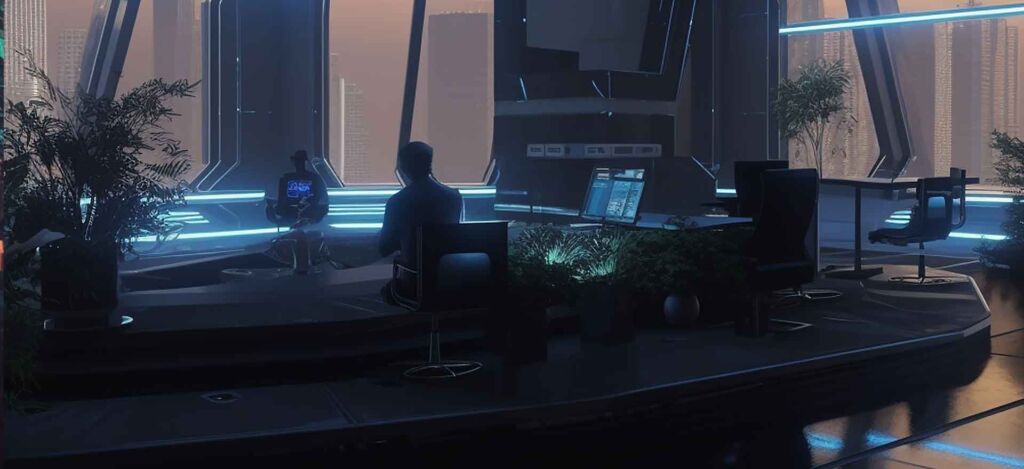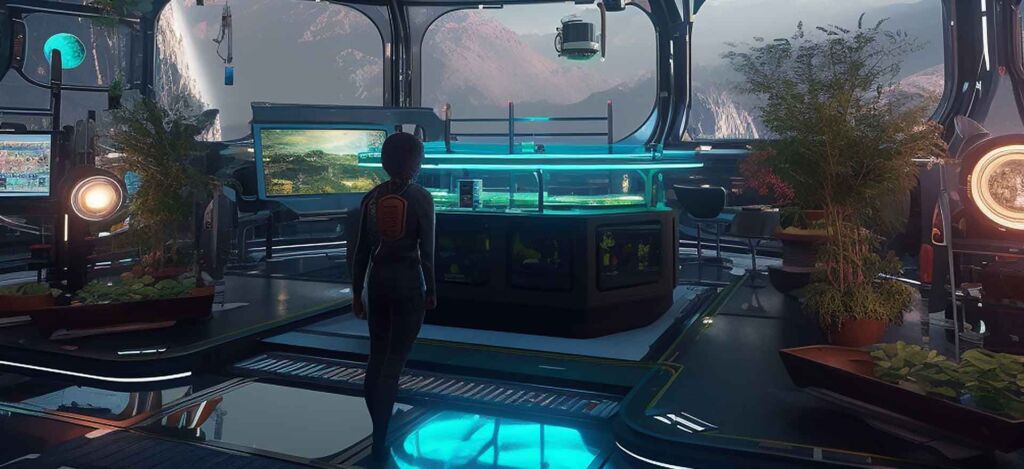Technologies and Platforms Shaping Our Virtual Future
The metaverse is a rapidly emerging and evolving digital universe, a convergence of virtual worlds, augmented reality, and the Internet. It allows users to interact with each other, create content, and experience immersive virtual environments in ways that were once only the stuff of science fiction. A range of technologies and platforms are driving the development of the metaverse, each with its unique advantages and applications. This blog post aims to provide a comprehensive guide to the technologies and platforms shaping the metaverse, including virtual reality, augmented reality, blockchain, and decentralized platforms. So, let’s dive in and explore the exciting world of the metaverse.
1.- Virtual Reality (VR)
1.1 Introduction to Virtual Reality
Virtual Reality (VR) is a technology that simulates a three-dimensional, computer-generated environment, allowing users to fully immerse themselves in a digital world. VR experiences can be highly realistic, simulating the senses of sight, sound, and touch, making it a vital technology in creating the metaverse.
1.2 Key VR Technologies and Platforms
VR technologies and platforms are transforming how we interact with the digital world. From gaming to healthcare, they offer engaging and immersive experiences that unlock our creativity and take us on incredible journeys. It’s time to explore the possibilities of VR and discover the amazing experiences that await you!
1.3 Oculus Rift and Oculus Quest
Oculus, now a part of Facebook’s parent company Meta, has been a frontrunner in the VR space since its inception. The Oculus Rift, initially launched in 2016, marked the beginning of the consumer VR revolution. In 2019, the Oculus Quest was introduced as a standalone VR headset, eliminating the need for a powerful computer to run VR experiences.
1.4 PlayStation VR
As a major player in the gaming industry, Sony’s PlayStation VR has brought immersive gaming experiences to millions of users worldwide. With a strong library of exclusive titles and compatibility with the PlayStation console, PSVR has become a popular choice for gamers looking to explore the metaverse.
1.5 HTC Vive
The HTC Vive, released in partnership with Valve, offers a premium VR experience with room-scale tracking capabilities. With its precise motion tracking and compatibility with Valve’s SteamVR platform, the HTC Vive has gained a dedicated user base.
1.6 Microsoft Mixed Reality
Microsoft’s Mixed Reality platform includes a range of VR headsets produced by various hardware partners, such as HP, Acer, and Samsung. These headsets use inside-out tracking technology, which eliminates the need for external sensors, making the setup more straightforward.
1.7 Challenges and Future of VR
Despite the significant advancements in VR technology, challenges remain, such as the high cost of entry, the need for powerful hardware, and the potential for motion sickness. However, as technology continues to improve and more content becomes available, VR is poised to play an essential role in the metaverse.
2.- Augmented Reality (AR)

2.1 Introduction to Augmented Reality
Augmented Reality (AR) is a technology that overlays digital information and virtual objects onto the real world, enhancing the user’s perception of their surroundings. AR has the potential to bridge the gap between the physical and digital worlds, making it an integral component of the metaverse.
2.2 Key AR Technologies and Platforms
Apple’s ARKit is a framework for developers to create AR experiences on iOS devices. With the iPhone and iPad’s widespread adoption, ARKit has enabled developers to create various AR applications, ranging from games to productivity tools.
2.3. Monetizing Virtual Lan2.4 Microsoft HoloLens d
ARCore is Google’s platform for building AR experiences on Android devices. With features such as environmental understanding, motion tracking, and light estimation, ARCore allows developers to create rich AR experiences for a vast range of Android smartphones and tablets.
2.4 Microsoft HoloLens
The Microsoft HoloLens is a mixed reality headset that combines AR and VR technologies, enabling users to interact with digital objects in the real world. As a standalone device, the HoloLens is equipped with advanced sensors and spatial computing capabilities, making it a popular choice for enterprise applications, such as training, remote assistance, and design.
2.5 Magic Leap
Magic Leap is a company that has developed its own mixed reality headset, the Magic Leap One. While its adoption has been limited, the company has focused on creating an ecosystem for spatial computing, targeting industries such as healthcare, entertainment, and manufacturing.
2.6 Challenges and Future of AR
While AR has seen significant advancements in recent years, challenges still exist, including limited field of view, device comfort, and processing power constraints. As AR technology continues to improve, it will play an increasingly important role in the metaverse, enabling seamless integration between the physical and digital worlds.

3.- Blockchain
3.1 Introduction to Blockchain
Blockchain is a decentralized, distributed ledger technology that enables secure and transparent transactions without the need for a central authority. Blockchain’s core features, such as immutability, security, and decentralization, have made it an essential technology for the metaverse, particularly in areas like digital asset ownership, currency, and governance.
3.2 Key Blockchain Platforms and Applications in the Metaverse
Ethereum is a decentralized platform that enables developers to build and deploy smart contracts and decentralized applications (dApps). With its native token, Ether (ETH), Ethereum has become the backbone for many metaverse projects, including Decentraland, The Sandbox, and CryptoVoxels.
3.3 Flow
Flow is a blockchain platform developed by Dapper Labs, the company behind CryptoKitties and NBA Top Shot. Flow is designed for high-performance applications, such as games and digital collectibles, making it a popular choice for metaverse projects like Genies and Drifters.
3.4 Polygon
Polygon is a layer-2 scaling solution for Ethereum, aiming to provide faster and cheaper transactions. By offering an easy-to-use platform for developers, Polygon has attracted a variety of metaverse projects, such as Somnium Space and Aavegotchi.
3.5 Solana
Solana is a high-performance blockchain platform that has gained traction in the metaverse space due to its scalability and low transaction fees. Projects such as Star Atlas and Aurora are leveraging Solana’s capabilities to create large-scale, immersive metaverse experiences.
3.6 Challenges and Future of Blockchain in the Metaverse
Blockchain technology faces challenges, such as scalability, energy consumption, and accessibility, that must be addressed to ensure its successful integration into the metaverse. As blockchain technology continues to evolve and mature, it will play a vital role in creating a decentralized and secure metaverse ecosystem.

4.- Decentralized Platforms
4.1 Introduction to Decentralized Platforms
Decentralized platforms are systems that rely on a network of distributed nodes rather than a central authority, ensuring data security, transparency, and user control. Decentralized platforms are a critical component of the metaverse, as they enable users to own and control their digital assets, identities, and experiences.
4.2 Key Decentralized Platforms in the Metaverse
Decentraland is a decentralized virtual world built on the Ethereum blockchain, allowing users to create, own, and monetize content and experiences. With its native currency, MANA, users can buy and sell virtual land, known as parcels, and participate in the platform’s governance.
4.3 The Sandbox
The Sandbox is a blockchain-based virtual world where users can create, own, and monetize games and experiences using the platform’s native token, SAND. The platform offers a suite of tools for users to design and build their own content, fostering a vibrant ecosystem of creators, players, and collectors.
4.4 Somnium Space
Somnium Space is a decentralized VR world built on the Ethereum blockchain and Polygon network, offering immersive experiences and allowing users to create and trade virtual land, assets, and experiences. The platform supports both VR and non-VR access, making it accessible to a broad range of users.
4.5 CryptoVoxels
CryptoVoxels is a decentralized virtual world based on the Ethereum blockchain, where users can create, own, and monetize voxel-based content. The platform’s simple yet powerful building tools have attracted a diverse community of artists, developers, and collectors, who are shaping the platform’s evolving metaverse.
4.6 Challenges and Future of Decentralized Platforms in the Metaverse
Decentralized platforms face several challenges, including user adoption, regulatory concerns, and technical limitations, such as scaling and interoperability. However, as these platforms continue to mature and address these challenges, they will play a crucial role in shaping a user-centric, decentralized metaverse that empowers individuals to create, own, and control their digital lives.
Conclusion
The metaverse is a rapidly evolving digital universe, fueled by a range of innovative technologies and platforms. Virtual reality and augmented reality are key technologies that enable users to immerse themselves in virtual worlds and seamlessly integrate digital experiences into their physical surroundings. Blockchain technology provides the foundation for secure and transparent transactions, enabling digital asset ownership, currency, and governance in the metaverse. Decentralized platforms built on blockchain technology empower users to create, own, and control their digital assets and experiences, fostering a user-centric metaverse ecosystem.
As these technologies and platforms continue to advance, the metaverse will grow in complexity, scale, and impact, forever changing the way we interact with the digital world and each other. As we explore this fascinating convergence of virtual worlds, augmented reality, and the Internet, it is essential to understand the technologies and platforms that are driving its development, as they will shape the future of our increasingly interconnected digital lives.


